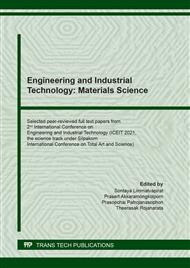[1]
T. Phaechamud, J. Mahadlek, S. Tuntarawongsa, Peppermint oil/doxycycline hyclate-loaded Eudragit RS in situ forming gel for periodontitis treatment, J. Pharm. Investig. 48 (2018) 451-464.
DOI: 10.1007/s40005-017-0340-x
Google Scholar
[2]
J.H. Guo, G.W. Skinner, W.W. Harcum, P.E. Barnum, Pharmaceutical applications of naturally occurring water-soluble polymers, Pharm. Sci. Technol. Today. 1 (1998) 254-261.
DOI: 10.1016/s1461-5347(98)00072-8
Google Scholar
[3]
R. Sheshala, G.C. Hong, W.P. Yee, V.S. Meka, R.R.S. Thakur, In situ forming phase-inversion implants for sustained ocular delivery of triamcinolone acetonide, Drug Deliv. Translat. Res. 9 (2019) 534-542.
DOI: 10.1007/s13346-018-0491-y
Google Scholar
[4]
T. Phaechamud, S. Senarat, N. Puyathorn, P. Praphanwittaya, Solvent exchange and drug release characteristics of doxycycline hyclate-loaded bleached shellac in situ-forming gel and -microparticle, Int. J. Biol. Macromol. 135 (2019) 1261-1272.
DOI: 10.1016/j.ijbiomac.2018.11.098
Google Scholar
[5]
N. Storozhylova, J. Crecente-Campo, D. Cabaleiro, L. Lugo, C. Dussouy, S. Simões, et al., An in situ hyaluronic acid-fibrin hydrogel containing drug-loaded nanocapsules for intra-articular treatment of inflammatory joint diseases, Regen. Eng. Transl. Med. 6 (2020) 201-216.
DOI: 10.1007/s40883-020-00154-2
Google Scholar
[6]
L. Wang, A. Wang, X. Zhao, X. Liu, D. Wang, F. Sun, et al., Design of a long-term antipsychotic in situ forming implant and its release control method and mechanism, Int. J. Pharm. 427 (2012) 284-292.
DOI: 10.1016/j.ijpharm.2012.02.015
Google Scholar
[7]
T. Srichan, T. Phaechamud, Designing solvent exchange-induced in situ forming gel from aqueous insoluble polymers as matrix base for periodontitis treatment, AAPS J. 18 (2017) 194-201.
DOI: 10.1208/s12249-016-0507-1
Google Scholar
[8]
T. Chantadee, P. Sawangsri, W. Santimaleeworagun, T. Phaechamud, Vancomycin hydrochloride-loaded stearic acid/lauric acid in situ forming matrix for antimicrobial inhibition in patients with joint infection after total knee arthroplasty, Mater. Sci. Eng. C. 115 (2020) 110761.
DOI: 10.1016/j.msec.2020.110761
Google Scholar
[9]
T. Chantadee, W. Santimaleeworagun, Y. Phorom, T. Chuenbarn, T. Phaechamud, Vancomycin HCl-loaded lauric acid in situ-forming gel with phase inversion for periodontitis treatment, J. Drug Deliv. Sci. Technol. 57 (2020) 101615.
DOI: 10.1016/j.jddst.2020.101615
Google Scholar
[10]
N. Fattahi, M.A. Shahbazi, A. Maleki, M. Hamidi, A. Ramazani, H.A. Santos, Emerging insights on drug delivery by fatty acid mediated synthesis of lipophilic prodrugs as novel nanomedicines, J. Control. Release. 326 (2020) 556-598.
DOI: 10.1016/j.jconrel.2020.07.012
Google Scholar
[11]
T. Chantadee, J. Sirirak, T. Hoshino, T. Phaechamud, Augmentative molecular aspect for phase inversion of vancomycin hydrochloride-loaded fatty acid in situ forming matrices, Mater. Des. 199 (2021) 109429.
DOI: 10.1016/j.matdes.2020.109429
Google Scholar
[12]
T. Phaechamud, C. Savedkairop, Contact angle and surface tension of some solvents used in pharmaceuticals, Res. J. Pharm. Biol. Chem. Sci. 3(4) (2012) 513-529.
Google Scholar
[13]
S. F.S. Mohamad, S. Mohamad, A.A. Aziz, The susceptibility of Aphids, Aphis gossypii Glover to lauric acid based natural pesticide, Procedia Eng. 53 (2013) 20-28.
DOI: 10.1016/j.proeng.2013.02.004
Google Scholar
[14]
F.M. Fowkes. 1983. Acid-base interactions in polymer adhesion. In: Kittal K.L., editor. Physicochemical Aspects of Polymer Surfaces. 2. Plenum Press. pp.583-603.
Google Scholar
[15]
K.D. Danov, P.A. Kralchevsky, K.P. Ananthapadmanabhan, A. Lips, Interpretation of surface-tension isotherms of n-alkanoic (fatty) acids by means of the van der Waals model, J. Colloid Interface Sci. 300 (2006) 809-813.
DOI: 10.1016/j.jcis.2006.04.026
Google Scholar
[16]
C. Ahn, V.K. Morya, E.K. Kim, Tuning surface-active properties of bio-surfactant sophorolipids by varying fatty-acid chain lengths, Korean J. Chem. Eng. 33 (2016) 2127-2133.
DOI: 10.1007/s11814-016-0082-x
Google Scholar
[17]
C.W. Jeon, S. Park, J.H. Bang, S. Chae, K. Song, S.W. Lee, Nonpolar surface modification using fatty acids and its effect on calcite from mineral carbonation of desulfurized gypsum, Coatings. 8 (2018) 43.
DOI: 10.3390/coatings8010043
Google Scholar
[18]
D.M. Small. 1986. The physical chemistry of lipids: from alkanes to phospholipids. Handbook of lipid research. 4. Plenum Press. New York. p.264.
Google Scholar
[19]
J.A. Camargo, A. Sapin, C. Nouvel, D. Daloz, M. Leonard, F. Bonneaux, et al., Injectable PLA-based in situ forming implants for controlled release of Ivermectin a BCS Class II drug: solvent selection based on physico-chemical characterization, Drug Dev. Ind. Pharm. 39 (2013) 146-155.
DOI: 10.3109/03639045.2012.660952
Google Scholar
[20]
M. Parent, C. Nouvel, M. Koerber, A. Sapin, P. Maincent, A. Boudier, PLGA in situ implants formed by phase inversion: Critical physicochemical parameters to modulate drug release, J. Control. Release. 172 (2013) 292-304.
DOI: 10.1016/j.jconrel.2013.08.024
Google Scholar
[21]
A. L. Viken, K. Spildo, R. Reichenbach-Klinke, K. Djurhuus, T. Skauge, Influence of weak hydrophobic interactions on in situ viscosity of a hydrophobically modified water-soluble polymer, Energy Fuels. 32 (2018) 89-98.
DOI: 10.1021/acs.energyfuels.7b02573
Google Scholar
[22]
Y. Liang, X. Yuan, L. Wang, X. Zhou, X. Ren, Y. Huang, et al., Highly stable and efficient electrorheological suspensions with hydrophobic interaction, J. Colloid Interface Sci. 564 (2020) 381-391.
DOI: 10.1016/j.jcis.2019.12.129
Google Scholar
[23]
T. Phaechamud, S.M. Thurein, T. Chantadee, Role of clove oil in solvent exchange-induced doxycycline hyclate-loaded Eudragit RS in situ forming gel, Asian J. Pharm. 13 (2018) 131-142.
DOI: 10.1016/j.ajps.2017.09.004
Google Scholar
[24]
H.A. Gad, M.A. El-Nabarawi, S.S. Abd El-Hady, Formulation and evaluation of PLA and PLGA in situ implants containing secnidazole and/or doxycycline for treatment of periodontitis, AAPS J. 9 (2008) 878-884.
DOI: 10.1208/s12249-008-9126-9
Google Scholar
[25]
M. Iwahashi, S. Takebayashi, M. Taguchi, Y. Kasahara, H. Minami, H. Matsuzawa, Dynamical dimer structure and liquid structure of fatty acids in their binary liquid mixture: decanoic/octadecanoic acid and decanoic/dodecanoic acid systems, Chem. Phys. Lipids. 133 (2005) 113-124.
DOI: 10.1016/j.chemphyslip.2004.09.022
Google Scholar


